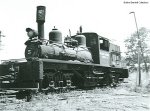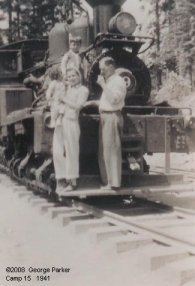It's not pretty, though I don't like to call it ugly. For after it has been in the family a while one gets used to it, and you might even coddle it a bit.
t.jpg)
It's a locomotive, not built for speed but for pulling power, and seldom goes over 20 miles per hour. As long as it can get traction it can pull 100 times its weight. I pulled that figure out of the air, but if you have a better one, please use it.
A picture does much better than my prose, so look as much as you wish to the end of this story, but I'll write out of my memories, since I lived around these workhorses many summers. We had 3 Shays of differing weights but the same configurations.(ed.note - Michigan-California Lumber Co and predecessors had 16 shays over their railroading years, though not all at one time.) The body sits on 2 trucks. The front of the body consists of the tubular boiler lying horizontally on the frame. It is completely sealed with tubes from the firebox running from rear to front and shrouded by an insulated casing. Behind this is the firebox whose flames pass through the tubes in the boiler, and pass out through the smokestack at the front, a fluted device with heavy screen covering it to contain cinders. Atop the boiler is a steam dome with a whistle on top, and, near, a steam pipe from the boiler to the cylinders. In front of the steam dome is another dome containing sand, where the heat keeps it dry. Sand is spread on the rails in front of the wheels to increase friction when needed.
To the right of the firebox, on the side of the engine, lie 3 vertical cylinders with the piston rods running down to a crankshaft, which runs both fore and aft to the trucks, where with bevel gears, it converts its rotating motion to the rotating motion of the drive wheels.
t.jpg)
Behind the firebox is a small working platform, and aft of that is the water tank. On the right of the platform is the engineer's seat and controls. On the left is the fireman's seat.
The engineer has 3 main controls: the Johnson bar, the throttle, and the brakes. The Johnson bar stands vertically at his right. In its middle position, no steam is applied to the cylinders. When moved forward, the train moves forward, and when pulled to the rear, the engine reverses. The farther forward or back position of the bar causes the input valves to stay open longer, giving more power to the engine. When cruising, the bar is pulled toward center, so less steam is used.
The throttle extends horizontally away from the boiler, and when pushed away, or pulled closer (I don't remember which), the volume of steam directed to the cylinders is controlled, thus determining the speed of the engine. The brake valve, which is like a faucet "finger" handle is at a convenient position in front of the engineer.
Above him is the whistle bar, with which the engineer can make beautiful music out of the 3-pipe whistle atop the steam dome. And to his left, on a frame attached to the boiler, are 3 little oil glasses, with tubes running out of their bottom to somewhere. Included is a mechanism that controls or forces the oil slowly out. I've thought this might be oil added to the steam as it enters the cylinders for lubrication, but I never truly learned their use.
The fireman has 3 jobs: observing signals from the brakemen and transferring them to the engineer; feeding the fire; and inserting water into the boiler. This last duty is tricky, for one has 3 valves to open in the right sequence, and quickly. Steam, coming from the boiler, passes through a venturi tube and sucks water from the water tank, and forces it, by means of its increased pressure, into the boiler. Also, attached to the boiler is a glass tube indicating the water level in the boiler and a gauge showing the steam pressure. And, the fun part for the fireman, he gets to ring the bell when getting under way or at a road crossing.
On the left side of the engine (have you ever seen a photo of it?) is an air compressor for the engine brakes (the cars have hand set brakes), a generator for lighting the headlights and cabin, and a water pump, with a hose neatly folded. This can be used to extinguish fires along the track, and also transfer water from the engine's tank to that of a donkey, which doesn't have a direct supply.

This is basically it. Firewood is stacked atop the water tank. There are connections at front and rear to hook to cars, and foot boards for brakemen. On the rear of the water tank are 2 sand containers with tubes leading to the track in front of the wheels when backing.
Oh, yes, there is one more thing! When an engine sits for a while, the steam in the cylinders condenses into water. Water doesn't compress, so that water needs to be expelled quickly before proceeding, so as not to damage the cylinder. This is done by opening a "bleeder valve" at the bottom of the cylinder, and when steam is added, the water and the steam come swishing out of the valve, sometimes as picturesque as "Old Faithful".
You've probably seen it. Standing by a steam locomotive, about to move, you suddenly jump back when that steam comes hissing out. Or maybe you've seen it in a movie. There, it's very dramatic. Picture this. Relax and close your eyes for a minute.
Now open them. You are in a darkened movie theater. The scene is a quiet railroad station near a ski resort in the mountains of Colorado, or Idaho, we were never told which. A passenger train is standing there, sleek and inviting. Above and beyond the train is a hill heavily packed with snow, with fir and pine trees reluctantly bending there snow-laden boughs. The platform is clear, having been swept this morning, and standing there, with his back to us is a man wearing a heavy wool coat and a fur hat. He is not moving, just standing and looking at a window in the train.
Through a train window, we see a woman, standing and removing a big coat, folding it and placing it on the seat. Then she removes her hat, places it on her coat and runs her fingers through her hair to tousle it, relieving its compression from the hat. She sits down at the window, twists her body and head and looks at the man on the platform. We note she is beautiful. We see no expression on her face, no mouthing of words, no waving of hands, just looking. Nor is there any movement by the man on the platform, he, too, is just looking. They have had a beautiful vacation. Perfect snow, perfect romance, perfect dining. They just look at each other. We are not privy to their thoughts, we can only guess.
Then the scene changes to the locomotive at the front of the train. We see a beautiful 3 drive-wheel steam engine. The shiny connecting rod from the massive cylinder extends and fastens to the equally shiny and massive silvery wheels. The body of the locomotive is black with a yellow stripe from front to back. And the lettering "Western Pacific Railway" on the water tank.
Then, the engineer opens the bleeder valve. And, suddenly, POUF! a blast of steam and water explode from the cylinder, nearly eclipsing our view. And, as the steam condenses, we see the connecting rod moving slowly forward; forward, down and around, then back, around and up, and the 3 wheels rotate in unison. Forward, down, around, backwards, around and up, and the wheels rotate faster and faster to the music of the exhaust steam as it poufs through the smokestack. It is a beautiful sight, like a pas-de-trois at the ballet.
The screen takes us back to the platform. The train is moving and they each strain their heads to get a last glimpse of each other. No mouthing of words, no waving of hands, just a final look.
The last of the cars passes. The man stands there for a full minute without moving, then slowly, he turns and walks to the waiting room.
She is on her way home to her husband; he is going home to his wife.
And, as the credits roll, we will return to our steady and faithful Shay, waiting patiently for us.


